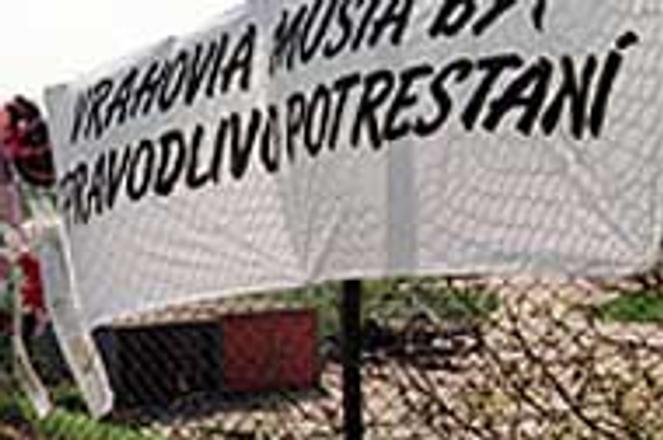A shrine marking where informer Róbert Remiaš died in 1996 bears a banner saying "murderers must be punished."photo: TASR
Police on November 25 put out a nationwide warrant for the arrest of two men suspected of planting the bomb that killed a Slovak police informant on April 29, 1996. The victim of the bombing, Róbert Remiaš, was acting at the time as a go-between for the crown witness in the kidnapping of the former president's son, Michal Kováč Jr.
The surprise announcement of the warrants, issued for Imrich Olah (40) of Bratislava and Jozef Roháč (43) of Levice, was made by Interior Ministry Chief Investigator Jaroslav Ivor during a regular press conference on November 29. Ivor caused a sensation by saying that the killers were known and were on the run from police. He said that the murder had been ordered by Košice underworld boss Miroslav Sýkora, who was himself murdered in February, 1997.
Roháč, who is known in the underworld by the name 'Rat,' is remembered for using a Health Ministry official as a shield in his 1985 attempt to flee across the border into Austria. He received 13 years for the kidnapping, but was freed in 1990 under a general amnesty for communist-era criminals issued by Czechoslovak President Václav Havel. Olah is known to have been a member of the gang of murdered Košice underworld boss Róbert Holub.
According to police, the bombing was the second attempt of Olah and Roháč to kill Remiaš. The victim died of shock several hours after 150-200 grams of an unknown explosive attached to the chassis of his BMW detonated near the Družba student dormitory in Bratislava.
Remiaš at the time had been feeding police information on the Kováč Jr. kidnapping from SIS officer Oskar Fegyveres, who was in hiding abroad and was to provide evidence that the Slovak secret service (SIS) had organized the kidnapping.
Opening old wounds
Just as the Remiaš killing divided the country in 1996 between those accusing the SIS of planting the bomb and those who said it was mafia-related, the recent warrant has revived bitter feelings between the political opposition and the government.
The announcement drew an angry reaction from the opposition Movement for a Democratic Slovakia (HZDS), which under the leadership of its chairman, former Prime Minister Vladimír Mečiar, had been in government at the time of the bombing. The HZDS vowed to initiate a parliamentary vote of non-confidence in Interior Minister Ladislav Pittner, who the party said had knowingly misled voters to believe that the SIS was responsible for the killing.
"The solving of the Robert Remiaš murder case shows that the murder was not ordered by the SIS but by the underworld," said HZDS spokesman Marián Kardoš in an official statement for the SITA news agency. "For this reason, the HZDS judges that the entire pre-election propaganda of the government, which was based on the role of the SIS in the killing, represented an intention to defraud the electorate. The HZDS will initiate a motion for [Pittner's] dismissal in parliament."
The HZDS protest drew a cool reaction from Pittner, who said that Ivor had in fact not drawn any concrete links between the Remiaš murder and the SIS or HZDS - but that such ties could not be ruled out. "I'm convinced that this [murder] was not just an underworld matter," he said. "When asked if the SIS stood behind the murder, [Ivor] said that the police had information on these kinds of contacts."
Meanwhile, the HZDS's Ľuboš Lackovič, who serves as the party's shadow Interior Minister, said the HZDS was debating whether to lay criminal charges "against all persons, who through their public statements or concrete actions have tried to scandalize the HZDS and have accused its members of criminal offences."
As the police hunt for the suspects, however, evidence in the Remiaš investigation implicating the SIS remains strong. In a report released on February 12, 1999 by current SIS boss Vladimír Mitro, "many proven facts support the accusation that the SIS was behind the murder of R. Remiaš."
The Mitro report mentioned the fact that Remiaš's telephone was bugged by the SIS from November 11, 1995 until his death, and that he had been constantly followed by the SIS under a mission code-named 'Broiler IV.' The fact that Remiaš had been under surveillance on the day of his death, Mitro added, added to the weight of suspicion against the secret service.
As it now stands, the case against Olah and Roháč rests on the evidence of an underworld informant. The informer has given the police a motive for the killing, but because it has not been confirmed, Ivor has so far said only that the bombing was linked to Sýkora.
The Remiaš killing and the Kováč Jr. kidnapping were the subjects of repeated criticism from the EU and western diplomats, which urged the Mečiar government to find the culprits and bring them to justice. The government shelved the Kováč Jr. case in 1997 for lack of evidence, while Mečiar on March 3, 1998 amnestied "crimes committed in connection with the kidnapping of Michal Kováč. Jr."



